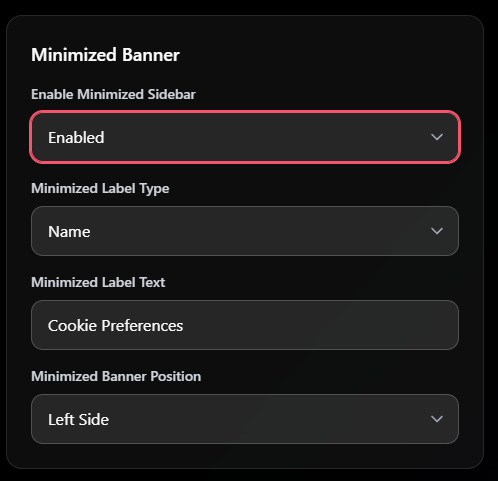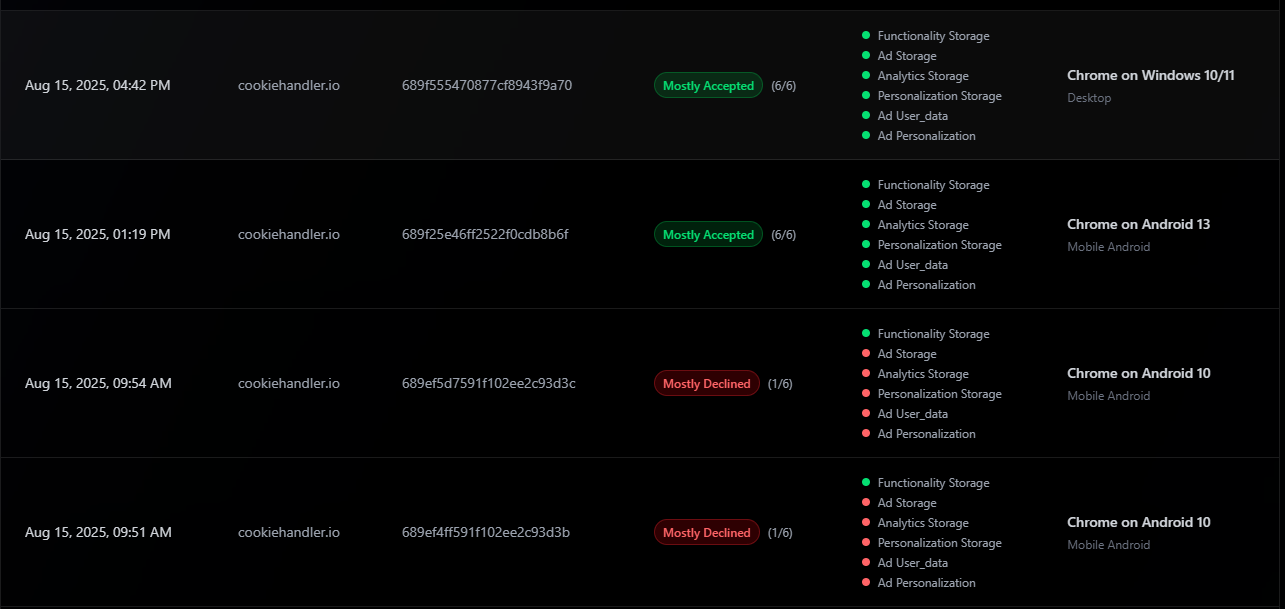Why Cookie Banners Must Always Be Present: The Opt-Out Version Explained
The GDPR Requirement: Consent Must Be Revocable
One of the most misunderstood aspects of GDPR compliance is why cookie banners need to remain accessible even after users make their initial choice. The answer lies in a fundamental user right: the right to withdraw consent.
Article 7(3): The Withdrawal Requirement
GDPR Article 7(3) states:
"The data subject shall have the right to withdraw his or her consent at any time... It shall be as easy to withdraw consent as it was to give consent."
This isn't a suggestion—it's a legal requirement that fundamentally changes how cookie consent must work.
Cookie Handler always allows users to opt out of non-essential cookies at any time. The responsibility for disabling the minimized banner (which provides ongoing opt-out access) lies with the user. Under GDPR Article 7(3), users have the right to withdraw consent as easily as it was given, and Cookie Handler ensures this is always possible.
- Legal Reference: Article 7, EU GDPR – "Conditions for consent"
- Key Points: Recitals 32, 33, 42, 43; Administrative fine: Art. 83(5)(a); Dossier: Consent, Proof, Obligation
- Article 7(3): "The data subject shall have the right to withdraw his or her consent at any time. It shall be as easy to withdraw as to give consent."
Consent logs are automatically recorded in the database and displayed on the dashboard. Each consent event is assigned a unique ID, making it easy to audit, track, and demonstrate compliance for every user and device.
What "Always Present" Actually Means
❌ Common Misconception
"Once a user clicks 'Accept All', I never need to show them the banner again."
✅ GDPR Reality
"Users must always have easy access to modify or withdraw their cookie consent."
The Implementation Requirement
Always accessible doesn't mean the full banner must always be visible—it means users must always have a clear, easy way to:
- Review their current consent choices
- Change their preferences
- Withdraw consent entirely
- Access your privacy policy
Different Approaches to "Always Present"
1. Persistent Mini-Banner
A small, unobtrusive banner that remains visible but collapses after initial interaction.
Pros:
- Always visible
- Minimal impact on user experience
- Clear compliance
Cons:
- Takes up permanent screen space
- Can be distracting
2. Cookie Settings Icon/Link
A dedicated "Cookie Settings" or "Privacy Preferences" link in your footer, header, or as a floating button.
Pros:
- Minimal visual impact
- Professional appearance
- Easy to implement
Cons:
- Less discoverable
- Requires user action to find
3. Privacy Dashboard
A dedicated privacy settings page accessible from your main navigation.
Pros:
- Comprehensive privacy controls
- Professional approach
- Can include additional privacy features
Cons:
- Requires more development
- May be less discoverable
4. Hybrid Approach (Recommended)
Combination of methods for maximum compliance and usability:
- Initial banner for new users
- Floating "Cookie Settings" button for returning users
- Footer link for additional access
- Privacy page for comprehensive controls
Why Users Need Continuous Access
1. Changing Privacy Preferences
User privacy preferences aren't static. Reasons users might want to change consent:
- Learning More: Understanding what cookies actually do
- Changed Circumstances: New job, different device usage patterns
- Privacy Awareness: Increased concern about data tracking
- Performance Issues: Disabling cookies that slow down their experience
2. Device and Context Changes
- New Devices: Consent is typically device/browser specific
- Shared Computers: Different users need different settings
- Public vs Private Browsing: Different privacy needs
3. Trust Building
Permanent access to privacy controls demonstrates:
- Respect for user autonomy
- Commitment to transparency
- Confidence in your privacy practices
Legal and Business Implications
Compliance Risks of Not Providing Access
GDPR Violations:
- Failure to provide withdrawal mechanism
- Making withdrawal more difficult than consent
- Not honoring withdrawal requests
Potential Consequences:
- Regulatory fines
- User complaints to data protection authorities
- Reputation damage
- Legal challenges
Business Benefits of Proper Implementation
Enhanced Trust:
- Users feel more comfortable knowing they can change settings
- Demonstrates commitment to privacy
- Builds long-term user relationships
Better Data Quality:
- Users who consciously maintain consent provide better data
- Reduces unwilling participants in tracking
- Improves targeting accuracy
Implementation Best Practices
1. Make it Discoverable
Cookie settings access should be:
- Clearly labeled (not hidden in legal jargon)
- Consistently placed across your site
- Visually distinct but not intrusive
2. Keep it Simple
The withdrawal process should be:
- As easy as giving initial consent
- No more than 2 clicks away
- Available without account creation
3. Immediate Effect
When users change settings:
- Apply changes immediately
- Provide confirmation
- Respect new preferences across all pages
4. Mobile Optimization
Ensure privacy controls work well on mobile:
- Touch-friendly buttons
- Readable text
- Accessible design
Common Implementation Patterns
Pattern 1: Floating Button
<!-- Floating cookie settings button -->
<button class="cookie-settings-btn"
onclick="openCookieSettings()"
aria-label="Cookie Settings">
🍪 Cookie Settings
</button>
Pattern 2: Footer Link
<!-- Footer privacy links -->
<footer>
<a href="/privacy-policy">Privacy Policy</a>
<a href="#" onclick="openCookieSettings()">Cookie Preferences</a>
<a href="/terms">Terms of Service</a>
</footer>
Pattern 3: Header Integration
<!-- Header navigation -->
<nav>
<a href="/about">About</a>
<a href="/contact">Contact</a>
<a href="#" onclick="openCookieSettings()">Privacy</a>
</nav>
Technical Considerations
1. State Management
- Track current user consent state
- Sync settings across browser tabs
- Handle consent expiration
2. Performance Impact
- Lazy load cookie management UI
- Minimize impact on page load
- Cache user preferences
3. Analytics Integration
- Track consent change events
- Monitor opt-out rates
- Measure user engagement with privacy controls
User Experience Guidelines
Do's:
- Use clear, plain language
- Provide immediate feedback on changes
- Make the interface intuitive
- Test on multiple devices and browsers
Don'ts:
- Hide privacy controls in obscure locations
- Make withdrawal harder than consent
- Use confusing or technical language
- Ignore mobile users
Measuring Success
Key Metrics:
- Discoverability: How many users find and use privacy controls
- Usage Patterns: What changes users make to their settings
- Satisfaction: User feedback on privacy control experience
- Compliance: Audit trail of consent changes
Conclusion: Building Sustainable Privacy Practices
Keeping cookie consent controls always accessible isn't just about legal compliance—it's about building sustainable, trust-based relationships with your users.
Users who know they can easily change their privacy settings are more likely to:
- Initially consent to beneficial tracking
- Trust your brand long-term
- Recommend your service to others
- Provide higher-quality engagement data
The companies that understand this will have significant advantages in building user trust and maintaining GDPR compliance.
Ready to implement always-accessible cookie controls? Cookie Handler provides persistent, user-friendly privacy controls that keep you compliant while building user trust.

